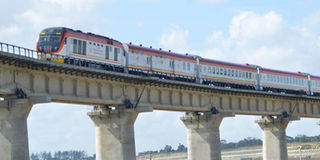SGR fails to break even for the fourth year running

The Madaraka Express train passes through Mombasa on the Miritini Bridge on October 16, 2017.
The Standard Gauge Railway (SGR) failed to break even for the fourth year running as operational costs remained high amid dwindling revenue, raising questions over the feasibility of the project that cost taxpayers billions of shillings.
The Mombasa-Nairobi SGR project, operated by China Communications Construction Company, cost taxpayers Sh327 billion with the Nairobi-Naivasha extension line costing another Sh150 billion.
Chinese loans
The financing of the two SGR lines is largely in loans from the Chinese government.
A report by the Parliamentary Budget Office (PBO) on the budget options for the 2021/22 financial year and the medium term shows that the cost of running the SGR far outweighs the revenues generated in its fourth year of operation.
This is despite the SGR contributing greatly by hauling cargo and passengers between Mombasa and Nairobi.
"The financial health of the project continues to be weak with accumulating pending bills often paid for through mid-year budgetary reviews, and project running costs relative to revenue," the report, currently before Parliament, says.
This means that the project cannot sustain itself without the government chipping in, meaning that the revenues generated for the last four years the project has been in operation cannot meet the operational costs.
Covid effects
The government had projected May 2019 as the year for the project to break even.
But even as the government blames the negative effects of Covid-19 for the project's economic downturn, data from the Ministry of Transport as captured by the PBO document shows that since the project was launched in June 2017, it has not been doing well financially.
Covid-19 was first reported in the country in March 2020.
For instance, between January and May last year, the cost of operating the SGR was Sh7.5 billion compared to the Sh5 billion that was realised in revenue.
The cost of running the SGR was the highest in 2019, hitting Sh18 billion against the Sh13.5 billion in revenues generated for the year.
In 2018 and 2017, the cost of operating the SGR far much outweighed the revenue.
In 2018, Sh14 billion was used to run the project against Sh5.5 billion that was generated.
Between June and December 2017, Sh7.5 billion was incurred in operational costs against Sh1 billion in revenue.
The emergence of the latest details will continue to raise questions as to whether the project is economically viable for the country or was a bad investment.
Not even the increase in cargo volumes to ferry 4,159 tonnes in 2019 by the operator made the difference.
But even as SGR continues to perform dismally, PBO notes that rail transport remains the best alternative for cargo haulage and long-distance passenger travel.
However, this will only make economic sense if the line gets beyond the country's borders.
The existing Meter Gauge Railway (MGR) network also needs to be modernised and extended to other parts of the country.
"Rehabilitation of the Nairobi-Nanyuki rail line is a significant step in the rail modernisation process," the PBO document says.
It continues: "The potential for rail transport lies in providing safe and comfortable passenger transport in large cities like Nairobi, and building interconnectivity across regions beyond the existing rail line systems."
In 2019, Kenya Revenue Authority (KRA) and Kenya Ports Authority (KPA) issued a joint controversial directive that all imported cargo leaving the port of Mombasa use the SGR and be cleared at the Inland Container Depot (ICD) in Nairobi.
This was in a bid to enhance its revenue flows.
The announcement was met with resistance from Coastal region political leaders and long-distance transporters who argued that it was bound to be a recipe for loss of jobs with a debilitating effect on the economy for an industry that supports over a million lives.
They cited the gains the government had made in warehousing, container freight stations (CFS) and the emerging satellite towns along the Mombasa-Nairobi highway.





